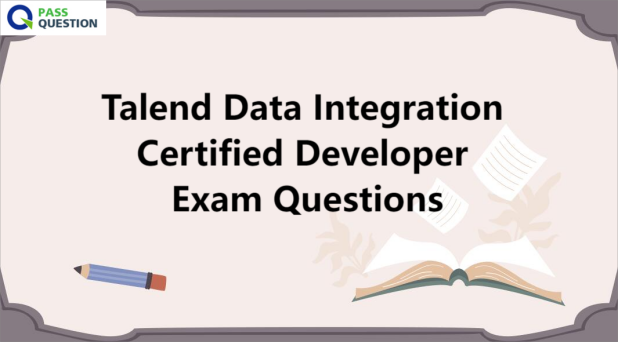Talend Data Integration Certified Developer Exam Questions
If you are interested in obtaining your Talend Data Integration Certified Developer certification, PassQuestion is the perfect choice for you. We offer a comprehensive collection of up-to-date and reliable Talend Data Integration Certified Developer Exam Questions that will equip you with all the necessary knowledge and skills to excel in the Talend Data Integration Certified Developer Exam. With our extensive range of Talend Data Integration Certified Developer Exam Questions, you will have everything you need to prepare for and pass the Talend Data Integration Certified Developer Exam. Start your preparation today and be confident in your ability to pass the Talend Data Integration Certified Developer Exam.

Talend Data Integration Certified Developer Exam
This certification exam covers topics related to the development of Talend Studio data integration Jobs. Topics include, but are not limited to, using Talend Studio in a stand-alone and collaborative team environment to build, analyze, and test Jobs, accessing files and databases, joining and filtering data, orchestrating complex tasks, and following best practices. The Talend Data Integration Certified Developer Exam has a duration of 90 minutes. It consists of 55 questions, and the passing score is 70%.
Recommended experience
- At least six months of experience using Talend products
- General knowledge of data integration architecture and advanced features such as parallelization
- Experience with Talend Data Integration solutions, including manual installation and configuration, project management, user management, Job deployment strategies, and troubleshooting of common issues
Exam Topics
Getting started with data integration
- Define Talend Data Integration
- Describe the Talend Studio GUI
- Create a simple Job
Joining and filtering data
- Define and configure Talend metadata
- Join two sources of data using the tMap component
- Define the tMap Join settings and its rejected capture mechanism
- Create a filter condition in tMap
- Configure a filter reject output along with multiple filtered outputs
Error handling
- Use triggers to create a sequence of subJobs
- Use logging components in a Job design
- Create ‘if’ triggers based on component variables
Orchestrating Jobs
- Explain a typical master Job use case
- Describe the order of priority to pass parameters in context variables
- Send dynamic parameters to a child Job by overriding context variables
- Explain Joblets and compare them to other orchestration primitives
- Refactor and create a Joblet from an existing Job
- Create a Joblet from the ground up
- Incorporate a Joblet into a Job
- Explain different parallelization options available in Studio
- Profile the execution of a Job with and without parallelism applied
Project management
- Explain key differences between a local and remote connection
- Configure a remote connection in Talend Studio
- Explain the key concepts of revision control (Git)
- Perform operations on revision control
- Define a reference project and use items from a reference project
Working with files
- Configure basic component properties
- Create and configure a Schema
- Use the tMap component and configure a simple mapping
- Use pre-defined Talend Java functions
Using context variables
- Define a standard context variable use case
- Use context variables in a Job
- Run Jobs in multiple contexts
Working with databases
- Define a database metadata
- Set actions on tables and data
- Customize SQL queries in database components
- Use metadata, generic schemas, and context variables in database components
Deploying Jobs
- Build a Job and understand its options
- Run a standalone Job
- Handle context variables in standalone Jobs
- Configure remote hosts in Studio
- Launch a Job on a remote host
View Online Talend Data Integration Certified Developer Free Questions
1. Which capabilities does Traces Debug provide? Choose 2 answers
A.Filtering which data is propagated by a flow
B.Advancing one column at a time
C.Breaking on a selected line of code
D.Breaking when an input column fulfills a condition
E.Advancing one row at a time
Answer: D, E
2. Which characteristics distinguish Traces Debug from Java Debug? Choose 2 answers
AAllow row-by-row inspection of data flows
BRequires a separate perspective
CRequire Java development experiences
DSupports breakpoints based on input data condition
Answer: A, D
3. Which method allows you to execute the compiled Job Talend Studio?
A.Click the Export button in the Edit Properties window.
B.Right-click the Job in the Repository and select Build Job
C.Right-click the Job in the Repository and select Export items.
D.Select Save As on the main File menu
Answer: B
4. You are collaborating on a project with other developers using talend best practices.
When should you use a tag?
A.Capturing snapshot of a codebase that requires ongoing maintenance.
B.Fixing hugs or enhancements.
C.Denoting major or minor releases.
D.Denoting a milestone in the lifecycle of a project
Answer: D
5. Which statement is true about the Sync columns button on the Basic settings tab of the Component view? Choose 2 answers
A.Retrieves and synchronizes the output file schema with the input file schema for tFileOutputed limited.
B.Retrieves the schema of the current component to match the Next component
C.Retrieves the schema from the input component connected in the lob.
D.Retrieves and synchronizes the output schema with the input schema for tJavaRow.
Answer: C, D
6. You are building a complex Job and want to explore different optionsfor optimizing execution timesusing parallelism.
How can you identify execution times to verify the effectiveness of your changes? Choose 2 answers
A.Observing the execution time in the Code view.
B.Heading the time stamps from the execution console in the Run view.
C.Comparing time stamp in Trace Debug mode.
D.Observing the execution times that annotate the flows in the Designer.
Answer: B, D
- TOP 50 Exam Questions
-
Exam
All copyrights reserved 2025 PassQuestion NETWORK CO.,LIMITED. All Rights Reserved.

